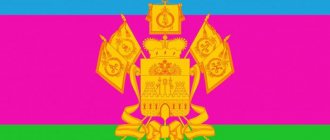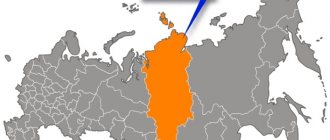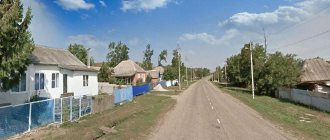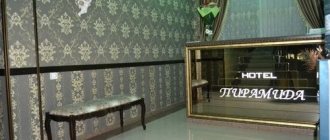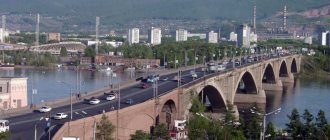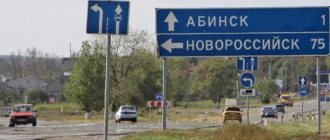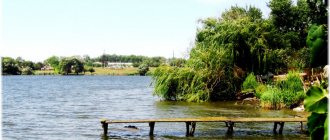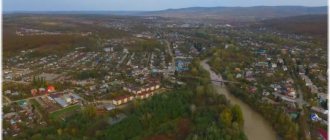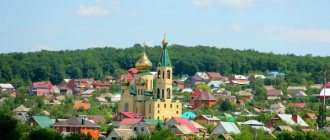In ancient times
Despite the proximity of the Black and Azov seas and the richness of natural conditions, before joining Russia this region was little developed - this was hampered by regular raids of nomads. The first permanent settlements began to be founded here 10 thousand years ago, as evidenced by numerous dolmens located in different places in the Krasnodar Territory, as well as in Transcaucasia.
Dolmens are giant stone tombs of various shapes, although it is still not entirely clear whether they are really tombs or structures for religious purposes. The Russian-speaking population that appeared in the North-West Caucasus in the 19th century called dolmens “heroic huts”, “didovs” or even “devil’s huts”. They were first discovered in the 18th century, but most of them are not under state protection and suffer from vandals.
Dolmen near Gelendzhik
In ancient times, there were colonies of ancient Greeks on the territory of the modern Krasnodar Territory, and in the middle of the 2nd century BC. Adyghe tribes settled here. In the Middle Ages, Genoese merchants also founded their colonies in this region, who got along well with the Circassians; Turks also lived here.
In the 10th century, the city of Tmutarakan was founded on the Taman Peninsula; this was the first Slavic settlement in these lands. The city existed until the Mongol-Tatar invasion.
At the end of the 15th century, Türkiye became the unchallenged ruler of the Black Sea. In Kuban, wars with nomads stopped. But the Nogais roamed the steppes of the right bank of the Kuban. Circassians settled in the foothills along the Black Sea.
History of the Krasnodar region
Area - 76 thousand square kilometers.
The population as of January 1, 2015 was more than 5.45 million people.
The administrative center of the region is the city of Krasnodar. Among the large cities are Sochi, Novorossiysk, Anapa, Gelendzhik.
The Krasnodar Territory includes 38 districts, 26 cities, 15 of which are regional and 11 of regional subordination, 21 urban-type settlements, 389 rural administrative districts, uniting 1,717 rural settlements.
The head of the administration (governor) of the Krasnodar Territory is Veniamin Kondratyev.
The basis of the productive forces of the Krasnodar Territory is the industrial, construction, fuel and energy complexes, the field of information and communication technologies, agro-industrial, transport, resort, recreational and tourist complexes.
As of the beginning of 2015, about 138 thousand organizations and 210 thousand individual entrepreneurs were registered in the region.
The achievements of the region brought Kuban well-deserved fame as the “breadbasket of Russia.” In physical terms, of what is produced in the Russian Federation, it gives the Russian consumer about 75% of rice, 40% of grain corn, 27% of sugar beets, 20% of sunflowers, 10% of grain. The basis of the agro-industrial complex of the Krasnodar Territory is made up of large diversified agricultural and processing enterprises, thousands of farms, and over 880 thousand personal subsidiary plots. Almost all tea and citrus fruits, and other subtropical crops produced in Russia, are grown in the Krasnodar Territory. Natural and climatic conditions are favorable for viticulture; about half of the all-Russian harvest is harvested in Kuban. The best Kuban wines are known not only in Russia, but also abroad; they have been awarded more than once at prestigious international and Russian competitions.
One of the largest agribusinesses in the South of Russia, AgroHolding Kuban, is located in the Krasnodar Territory. AgroHolding Kuban is among the TOP 20 largest agricultural companies in Russia and the TOP 5 most efficient land users in the country.
The industrial complex of the Krasnodar Territory is widely represented by energy, mining, and manufacturing enterprises, in which the leading positions are occupied by food industry enterprises, widely known in Russia and abroad.
Industry accounts for 30% in the output of products and services of the basic sectors of the regional economy, and 16% in the formation of the gross regional product.
A distinctive feature of the industrial infrastructure of the Krasnodar Territory is the high degree of concentration of specialized industries in the main industrial centers - Krasnodar (where more than a third of the regional industrial potential is concentrated), Armavir and Novorossiysk.
The fuel and energy complex of the region includes more than 300 enterprises of various forms of ownership, which employ about 60 thousand people, produce more than 25% of Kuban's industrial products and transfer more than 10% of all tax revenues to the budget of the Krasnodar Territory.
An important place in the economy of the region is occupied by oil and gas production and oil refining. It was in Kuban that the domestic oil and gas industry was born - here in 1864 the first oil well in Russia was drilled. Over the entire period of active exploitation of fields in the Krasnodar Territory, about 230 million tons of oil and 400 billion cubic meters of gas were produced.
The vast majority of deposits are concentrated on the left bank of the Kuban, in the area of the Severskaya and Akhtyrskaya villages, in the Abinsk region, the valley of the Psekups River and in the Anastasievsko-Troitsk oil basin. The main “long-livers” are the Khadyzhenskoye and Slavyanskoye fields, which have been in operation for more than 40 years; among the youngest are the Sladkovsko-Morozovskoye field.
The oil refining industry of the Krasnodar Territory is represented by five enterprises, including three large ones: RN-Tuapse Oil Refinery LLC, Afipsky Oil Refinery LLC; CJSC "Krasnodar Oil Refinery - Krasnodarekoneft".
The most direct influence on the formation of a stable economy of the Krasnodar Territory is exerted by the activities of enterprises in the forestry, woodworking and pulp and paper industries. Timber and its processed products are one of the sources of foreign exchange earnings from exports. One of the leading enterprises in the industry is Mostovskoye OJSC "Yug", which carries out a full cycle of work.
The contribution of construction materials industry enterprises to the economy of the Krasnodar region is significant, accounting for 8.5% of industrial output and 10% of labor resources.
The transport complex of the region is one of the most important elements of the economy not only of Kuban, but also of the entire Russian Federation. The sea ports of the Krasnodar Territory are Russia's main outlet to the Mediterranean countries and provide up to 40% of the cargo turnover of all Russian ports. Two of Russia's largest international transport and energy projects operate here: the Russia-Turkey Blue Stream gas pipeline and the terminals of the Caspian Pipeline Consortium.
Foreign trade turnover of the Krasnodar Territory in 2014 compared to 2013 increased by 12.8%, exceeding $15 billion. At the same time, exports from the region increased by 29% to $10 billion.
The main share of exports fell on two product groups - fuel and oil, as well as cereals.
Krasnodar region is one of the largest cultural centers in Russia. About 400 different holidays, festivals, and forums are held in the region every year. Among them are the festivals “Kuban Musical Spring”, “Golden Apple”, “Kinotavr”, “Kinoshok”, “Singing Russia”, “Kuban Spaces”.
There are museums in the region: Krasnodar State Historical and Archaeological Museum-Reserve named after E.D. Felitsyn; Krasnodar Regional Art Museum; Novorossiysk Historical Museum-Reserve.
Russia's triumph was the hosting of the 2014 Winter Olympic Games in Sochi. In August 2015, the Museum of the Opening Ceremony of the Olympic Games opened in the Sochi Olympic Park.
Among the natural monuments of the Krasnodar Territory are the Agur waterfalls, the Vorontsov caves, the Fisht mountain group, the Guam Gorge, and the Sochi Arboretum.
At least 2 thousand dolmens—funeral structures from the Late Bronze Age—are known on the territory of the region.
There are dozens of ancient monuments located on the Azov-Black Sea coast of the Krasnodar Territory.
The most significant of them are Hermonassa-Tmutarakan (Taman), Gorgippia (Anapa), Phanagoria and Kepy (Sennaya village), Patrey (Garkushi village). The faunal complex “Bogatyrs” and a tomb were discovered on the territory of the necropolis of ancient Phanagoria.
Thanks to the combination of favorable climatic conditions and the presence of deposits of mineral waters and medicinal mud, the Krasnodar Territory is the most popular resort and tourist region of Russia and, in fact, the only seaside balneological and resort recreation center in Russia. During the period of maximum expansion, the daily capacity of the region’s resorts reaches 450-480 thousand places. The potential of the sanatorium-resort and tourist complex of the region is realized through the creation of a special economic zone of a tourist-recreational type on the territory of the region.
Resorts of the Krasnodar Territory were included in the rating of popular resorts and vacation spots in the high season of 2015 by the online hotel booking service Oktogo.ru. Topped the list of popular resorts in Sochi. The TOP 10 also included Anapa, Gelendzhik and Dzhubga.
"Nekrasovtsy" in Kuban
The second wave of settlers began with the arrival of the “Nekrasovites” - Cossacks under the leadership of the Cossack leader Ignat Nekrasov - to Kuban.
In the fall of 1708, after the defeat of the Bulavin uprising, part of the Don Cossacks, led by Ataman Nekrasov, went to Kuban. Then this territory belonged to the Crimean Khanate. According to various sources, from 2 thousand to 8 thousand Cossacks with their wives and children left with Nekrasov (this is approximately 500-600 families). They united with the Old Believers Cossacks who had previously left for the Kuban and formed the first Cossack army in the Kuban, which accepted the citizenship of the Crimean khans and received broad privileges. Runaways from the Don, as well as ordinary peasants, began to join them. The Cossacks of this army were called “Nekrasovtsy”, although it was very heterogeneous.
The “Nekrasovites” first settled in the Middle Kuban (on the right bank of the Laba River), near the modern village of Nekrasovskaya. But then a significant majority, including Nekrasov himself, moved to the Taman Peninsula (near Temryuk) and founded three towns: Bludilovsky, Golubinsky and Chiryansky.
But since the “Nekrasovites” made constant raids on the Russian border lands, they began to fight them. After the death of Ignat Nekrasov, they were offered to return to their homeland, but to no avail, then Empress Anna Ioannovna sent troops to Kuban, and in 1791 the last “Nekrasovites” left for Bessarabia and Bulgaria.
Tourism
Even during the times of Imperial Russia, a tradition developed according to which the highest authorities of the country preferred Crimea for recreation; spacious villas and other related infrastructure were built there. And mostly middle-income people went to the Caucasus and Kuban; this place was not yet adapted for a comfortable pastime, although the geographical location of the Krasnodar Territory creates ideal conditions for any type of recreation.
Everything changed in Soviet times, when hotels and sanatoriums for both workers and members of the elite began to be built along the Black Sea coast. Tourist routes opened, beach holidays were organized normally.
After the collapse of the USSR, in the Krasnodar Territory, as well as throughout the country, there was devastation for a long time, the tourism business did not develop in any way, and the income of the population did not allow large numbers of people to travel to resorts.
Reign of Catherine II
During the reign of Catherine II, the colonization of the Kuban and the Caucasus began. Catherine’s plans included the empire’s access to the Black Sea and the conquest of the Crimean Khanate, but the constant confrontation with Turkey complicated the implementation of this plan. When the Crimean Khanate fell, relations between the Nogais and Circassians in the Kuban worsened, they began to raid each other.
In 1774, after the conclusion of the Kuchuk-Kainardzhi Treaty, Russia gained access to the Black Sea and Crimea.
In this regard, there was no longer a need to preserve the Zaporozhye Cossacks. In addition, their traditional way of life often led to conflicts with the authorities. After the Cossacks supported the Pugachev uprising, Catherine II ordered the disbandment of the Zaporozhye Sich, which was carried out by General P. Tekeli in June 1775.
Alexander Vasilievich Suvorov
In 1778, Lieutenant General Alexander Vasilyevich Suvorov was sent to pacify the Russian border. On the right bank he built several fortresses for defense against the highlanders, established friendly relations with many Circassian princes, this stopped mutual raids for some time.
Suvorov divided the population of the Kuban region into robbers and the main part of the people living in peaceful labor. He reported: “No peoples have been observed arming themselves against Russia, except for a certain very small number of robbers, to whom, according to their craft, it does not matter whether they rob a Russian, a Turk, a Tatar, or one of their own fellow inhabitants.” After the annexation of Crimea to Russia, in 1783, Suvorov again visited Kuban, where he swore an oath of allegiance to the Nogai tribes, then suppressed the rebellion of the Nogais, who then moved to the steppes of Stavropol.
Suvorov's first visit to Kuban lasted only 106 days, but during this time he was not only able to build a demarcation cordon line 500 miles long (from the Black Sea to Stavropol), but also fulfill the mission of a peacemaker. Leaving Kuban, Suvorov reported: “... I leave this country in complete silence.”
He always taught his soldiers peace and harmony, did not tolerate looting, was a tolerant person, and he was surrounded by representatives of different nations: Ukrainians, Poles, Georgians, Armenians, representatives of small Caucasian peoples. He assessed people not by nationality, but by their deeds, intelligence and loyalty to Russia.
In 1787, Catherine II, together with Potemkin, visited Crimea, where she was met by the Amazon company created for her arrival; in the same year, the Army of the Faithful Cossacks was created, which later became the Black Sea Cossack Army. In 1792, they were granted Kuban for eternal use, where the Cossacks moved, founding the city of Ekaterinodar.
Nature
The Krasnodar region, whose area is 76 thousand square kilometers, boasts a wide variety of flora and fauna. Vast areas of forest land contain rare species of trees. Previously, Kuban was the main supplier of valuable wood, but now there is a trend towards preserving the unique forest fund, protected reserves are being formed.
Many representatives of the fauna living in the Krasnodar region are listed in the Red Book; among rare animals and birds one can note the Caucasian otter, the short-tailed snake eagle, the white-tailed eagle and many others. Life in fresh water is very rich and diverse; reeds, white flowers, steam-water walnuts grow along the Kuban River, and lilies are found in some places.
For Russians tired of prolonged frosts, the climate and nature of this region are a real salvation; many come here every year.
Founding of Ekaterinodar
Ekaterinodar was founded in 1793 by the Black Sea Cossacks, first as a military camp and later as a fortress. The city received its name in honor of the gift of the Kuban land by Empress Catherine II to the Black Sea Cossacks (Ekaterinodar - Catherine's Gift). Since 1860 it has been the administrative center of the newly formed Kuban region. Ekaterinodar received city status in 1867, and with the holding in the 70-80s of the 19th century. railway in the North Caucasus (Tikhoretsk - Ekaterinodar - Novorossiysk), it turned into a large commercial, industrial and transport center of the North Caucasus.
Monument to Catherine II in Krasnodar
Place of residence
There are 26 large cities, 12 urban-type settlements and 1,725 villages in the region. Every year the data changes, this is due both to the construction of new villages and to the status of some urban settlements.
The most populated areas of the Krasnodar Territory are Tuapse, Tikhoretsky, Slavyansky, Crimean districts. It is here that the largest centers are located, such as the administrative center of the region, Sochi, Novorossiysk, Anapa, Gelendzhik.
The large cities of the Krasnodar Territory have concentrated the entire industrial potential of the region around them. Electric power, mining, mechanical engineering, production of building materials - all this makes up half of the economy. More than 40% of the market is occupied by the food industry, because the Krasnodar region to this day remains the breadbasket of Russia, supplying wheat, rice and other agricultural products to all regions of the country.
Kuban in the 19th century
In the 19th century, Kuban began to actively develop. In the 2nd half of the 19th century. Kuban industry is developing especially rapidly.
Kuban Cossacks in the 19th century. fulfilled their main task - military service in the Russian army. Each of the Cossacks going into service purchased a horse, bladed weapons, and uniforms at their own expense.
During the Russian-Turkish War in 1877-1878. Kuban Cossacks were part of the active Russian army.
In the Danube Army on the Balkan Peninsula there was a cavalry regiment, two squadrons and two hundred plastuns.
In the 19th century The social composition of the population is radically changing. Peasants freed from serfdom began to arrive in the region from the central regions. The share of the “non-resident”, non-Cossack population begins to increase. The Black Sea coast is being populated en masse, and new Cossack villages are being formed in the Trans-Kuban region.
Population composition
According to official data from the 2010 census, 5.5 million people live in the region. And the administration of the Krasnodar region notes annual population growth.
This is the third largest region in Russia, with more only in Moscow and the region. Moreover, unlike other subjects, the ratio of urban and rural residents making up the population of the Krasnodar Territory is almost the same, which is associated with the historical tradition of settling in small villages and villages.
Representatives of more than a dozen nations chose different areas of the Krasnodar Territory as their home; in 2010 they lived here:
- the overwhelming majority are Russians - more than 80%;
- the share of the Cossacks varies within 0.1%;
- large diaspora of Armenians – about 5.5%;
- Ukrainians – 1.6%;
- The figure is even lower for such peoples as Greeks, Tatars, Belarusians, Georgians, Germans, Adygeis, Turks, Azerbaijanis and Ossetians.
In 2016–2017 There has been a surge in migration to the region from other constituent entities of the Russian Federation. And this is not only the workforce, many wealthy citizens move here for permanent residence, buy real estate here, and open their own businesses.
Future plans
Large cities of the Krasnodar Territory are provided with a developed transport system. The region operates:
- five airports, three of which have international status;
- federal railways pass through the territory;
- four modern highways;
- water transport for international and domestic purposes operates.
Among the most realistic plans is the construction of the Kerch Bridge across the strait; it will connect Kuban and Crimea, which will significantly simplify communication with this region.
Both in Krasnodar itself and in other cities, it is planned to develop the public transport network much more widely, primarily through the construction of new trolleybus and tram tracks. In 2022, the governor promised to pay special attention to the growth of the industrial structure of the region, including the production of building materials.
For Russian people, the Krasnodar region is associated with the sea, recreation, and a warm climate. But, besides this, the region has been the main supplier of agricultural products for Russia and abroad for many years.
Important events
Today, the Krasnodar region is an area for all kinds of new beginnings and large-scale achievements. This was shown in 2014, when Russia successfully held the Olympic Games, which received favorable responses from all over the world. The history of the Sochi competitions is also unusual because the sports and economic infrastructure was built almost from scratch, and both the population of the Krasnodar Territory and volunteers from all over the country participated in creating the new image of the region. There have never been such precedents in world practice.
In the same year, the Formula 1 Grand Prix took place; the track built became one of the best for this sport. The race took place along picturesque mountain roads and remained in the memory of the local population for a long time.
Tourism industry today
Everything changed at the beginning of the new millennium. After Sochi was chosen as the capital of the future Olympic Games in 2014, the administration of the Krasnodar region secured financial support from federal structures, and massive construction began throughout the region. Hotels that meet international standards, stadiums, ski slopes, water parks, etc. appeared. Roads were completely rebuilt, old buildings were reconstructed, and the appearance of the entire region, and especially Sochi, was reconstructed.
A powerful advertising campaign took place across the country, offering citizens a vacation in the Krasnodar region; it coincided with the difficult situation in Egypt and Turkey, so that in 2015 and 2016 people predominantly chose the Russian tourist destination.
